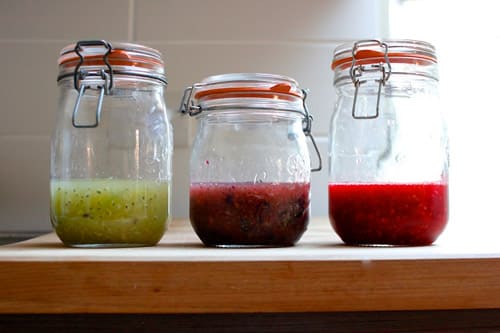Our site uses cookies to give you the best experience. or continue shopping if you're happy.
Accept & closeHow to Make Your Own Sweet Fruit Vinegars
Use your summer's harvest for these gorgeous dressings!
"A few weeks ago, I had my first sip of gooseberry vinegar. The lady in the shop decanted it from a huge, glowing vat to allow me to sip, intrigued, from a little shot glass. Honeyed and ambrosial, its sweet-sharp, muscat fragrance captivated me and I found myself wanting to go back for more. I never thought I’d end up drinking vinegar, but this was so luscious and delicious that I could genuinely imagine using it as a cordial, topped up with some ice-cold water, as the shop assistant suggested. The blackcurrant variety – naturally I had to sample this too - was possibly even more delicious, capturing that chocolatey, grassy bitterness that is a hallmark of this powerful little berry, combining it with sugar to give you a mouth-puckering, Ribena-scented taste experience that is oddly moreish."
I’ve been going to the pick-your-own farm a lot in the last few weeks, and have found myself unable to resist buying jewel-like berries by the crate. Once you’ve made a certain amount of frozen yoghurt and crumble, you find yourself wanting to enjoy summer’s bounty in other ways. With a freezer already full to bursting, I decided to have a go myself at making some of my own gorgeous fruit vinegars to add a bit of fruity tang to summer salads, sauces, desserts and dressings.
This recipe is from Diana Henry’s wonderful book Salt Sugar Smoke, though I’ve adapted it to make three different varieties of fruit vinegars: blackcurrant, raspberry (you can make it plain or add redcurrants too – I had a glut), and gooseberry. It involves no more effort than crushing some fruit with vinegar, leaving for a few days, straining then boiling with sugar, although you do need to allow yourself about a week to let the vinegar macerate. However, there’s very little hands-on time, and the reward is immense.
Few things have struck me as more beautiful this summer than a countertop sporting three glowing bottles of deep-hued fruit vinegar. The sheer pleasure involved in making these might surprise you, too – blackcurrants, raspberries and redcurrants produce the most incredible, vibrant juice, and there’s something immensely satisfying about crushing them and releasing all that potent liquor to mingle with the sweet tang of sugared vinegar. Show them off with pride in beautiful bottles with hand-written labels; presented this way they even – dare I say it – make fabulous Christmas presents, giving a little taste of summer’s heyday in the depths of winter.
Unsure how to use these luscious concoctions? Here are some recipe suggestions
Gooseberry vinegar
Gorgeous drizzled over a salad of cooked salmon, avocado and green beans; use to make a vinaigrette for a fresh goat’s cheese salad; wonderful on the side of a plate of pan-fried mackerel; add a little to the gooseberries in a crumble for a fruity tang; use as a fruity dipping sauce for Vietnamese-style spring rolls with mackerel, or skewers of grilled halloumi.
Blackcurrant vinegar
Brilliant with most cheeses – use in the vinaigrette for a blue cheese and pear salad, perhaps, or a goat’s cheese salad with walnuts; try a little added to the apples in a crumble; add to fresh blackcurrants to make a fruity compote to serve over cheesecake, meringue or pancakes, or add to blackcurrant sorbet or ice cream.
Raspberry vinegar
Try in a goat’s cheese, avocado and pecan salad; excellent in a vinaigrette for a roast chicken salad with watercress and toasted almonds; good with a flaked mackerel and lentil salad; add to raspberries to make a tangy compote to serve with an almond cake or tart, or over rice pudding or porridge.
The recipe below is for three varieties of fruit vinegar, but you can of course make several bottles of just one type of fruit, in which case obviously just make it all in a single jar.
Here's what you'll need...
- 280g blackcurrants (for some reason these release less liquid than the other two fruits, so you need a little more)
- 250g raspberries, or a mixture of raspberries and redcurrants
- 250g gooseberries
- 480ml cider vinegar
- Around 500g granulated sugar
- You will also need 3 x 250ml bottles with vinegar-proof lids, 3 large jars to macerate the fruit in and 3 jelly bags
Step 1
First, thoroughly clean three large glass jars (I use Kilner-style preserving jars). Put your different fruits in each jar, then divide the vinegar between the jars (160ml in each jar). Using a potato masher, squash the fruit and vinegar together well to combine.

Step 2
Seal the jars and put in a cool, dark place for around five days (I left mine for seven).

Step 3
After this time, pour each of the fruit/vinegar mixtures into a separate jelly bag and leave to strain over a bowl overnight (you can sit them in sieves over bowls if you have nowhere to hang them from, although a broom balanced between two chairs works well!).

Step 4
The next day, measure out the resulting liquid. For every 100ml, add 75g granulated sugar, and place in a saucepan. Bring to the boil slowly, stirring to dissolve the sugar, then boil for around 5 minutes, skimming off any scum that rises to the surface.

Step 5
Meanwhile, sterilize your glass bottles and lids (wash them well then put in the oven at 120C for 30 minutes). Allow the vinegar to cool before pouring it into the bottles and sealing. Store in a cool, dark place for up to a year.


